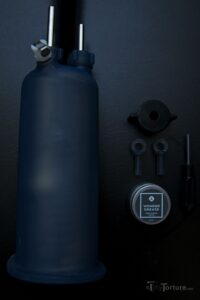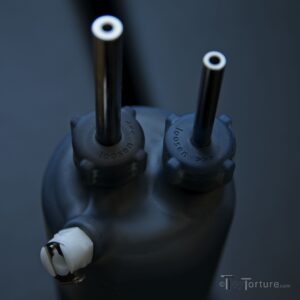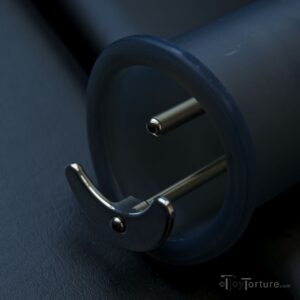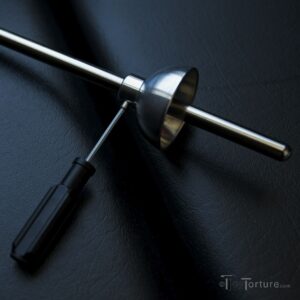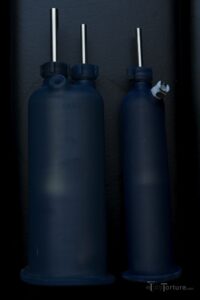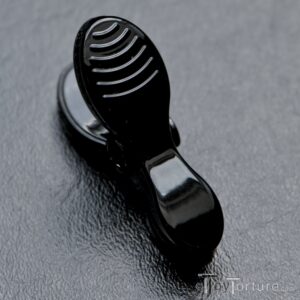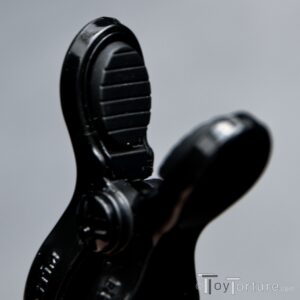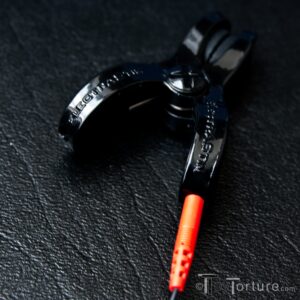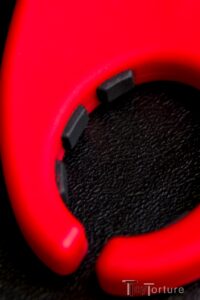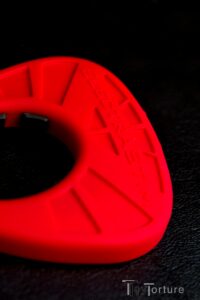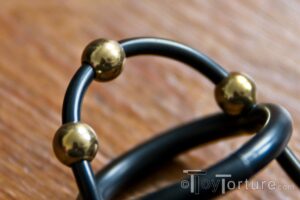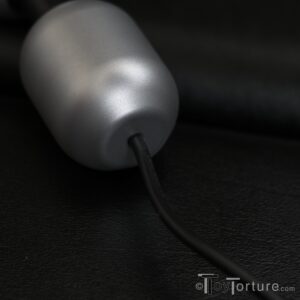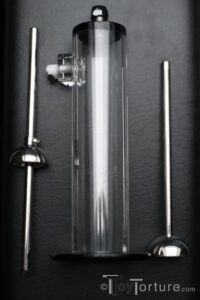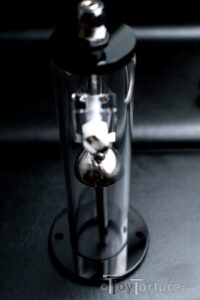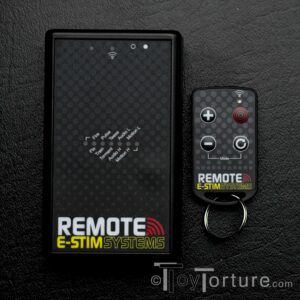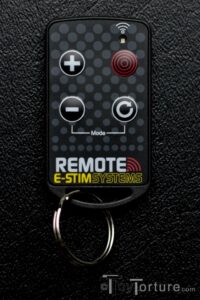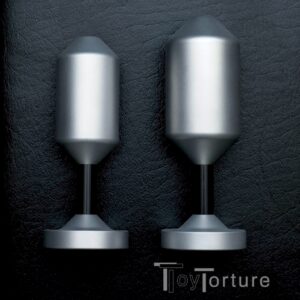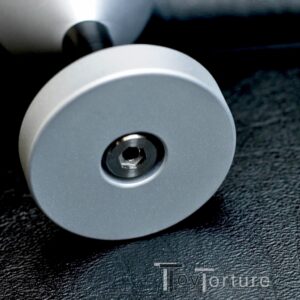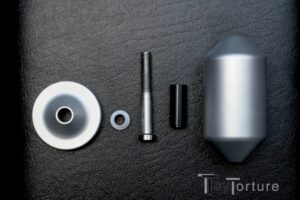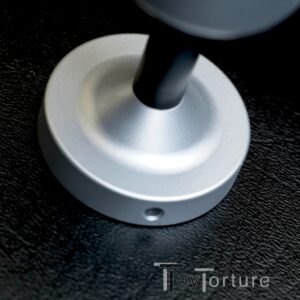Vendor: VAST
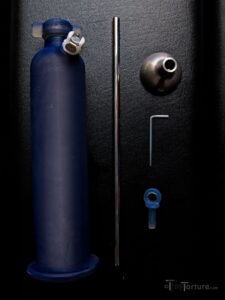
The VAST eVac 2.0 Disassembled
Exactly five years ago I reviewed the original eVac from VAST. Back then, we were all stuck at home, having too much time on our hands to play with ourselves. So let’s see if this second edition is a real upgrade, especially now that we are playing in sex clubs much more again.
Construction
Like its predecessor the eVac 2.0 is a standard vacuum cylinder. The tube has an internal length of 220mm and comes in two diameters: 50mm and 60mm. If you have a really big dick, VAST can probably make you a custom larger one to fit your junk. Laterally on the domed top sits a standard vacuum valve from CPC which is compatible with all common vacuum pump hoses. The tip ends in a thread with a wing nut which is essential for sealing a vacuum around the accessories which turn the eVac (2.0) a unique e-stim toy.
Unlike its predecessor it is not made out of acrylic parts glues together buy 3D printed, making it both lighter and more nimble. The ready to use eVac 2.0 with the half-dome weights 350g vs 440g of the old eVac in the same configuration. So even when the sub wiggles a lot or you want to move around during selfplay, it sits more securely. Another advantage is easy cleaning. Both the tube and the stainless steel rod are dishwasher safe. The aluminum half-sphere is not! After a dishwasher cycle, both the seal and the thread are degreased. In order to create a secure vacuum seal, use low viscosity silicone lube.

The Thread on top with the Wing Nut unscrewed, Electrode inserted and the Plug ready to replace the Sound
While the old eVac was a bit clunky, the 2.0 is almost stylish. The coloring caused a bit of a dispute among my testees: Unlike the clear acrylic of the old model, the printing polymer has a dark steel blue color and is opaque. Silicone oil will make the material a little bit more translucent and will make the growing dick glide up the walls more easily. Both the tube and the stainless steel rod are dishwasher safe. The aluminum half-sphere is not! After a dishwasher cycle, both the seal and the thread are degreased. In order to create a secure vacuum seal, use low viscosity silicone lube.
Another big advantage of the new manufacturing technique is the anatomically shaped base. The old one had a flat, almost absurd wide causing leverage problems base with a rounded edge. The new one not only distributes the pressure more evenly around the groin but creates a better and smoother vacuum seal, even when moving around.
The eVac 2.0 comes with two accessories to put into the thread on top. The first is a simple, yet essential one: A small 3D printed plug with an eyelet on top to seal the tube. When this plug is inserted, you can use the eVac 2.0 like every other vacuum cylinder. The star of the show which gives the eVac its name is a 280mm long stainless steel rod. This rod comes in 8mm diameter (what I chose) or 10mm diameter for the more advanced player. The rod diameter is indicated by the last to digits of the product namen; my eVac 2.0 with the 8mm rod is aptly named 508, the 10mm version would be names 510. One end is rounded, the other is has jack for a 4mm banana plug. The final accessory is a milled and polished aluminum half-sphere which flows into a short tube on top. The aluminum not only safes weight but enhances conductivity. The rod fits through the tube and can be fixed in place with a small setscrew using the enclosed hex key.
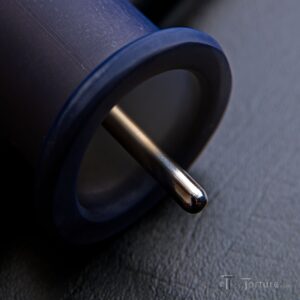
The Anatomical Shaped Base
Everything is packed in a drawstring bag for easy and scratch-free storage.
When I first read the price, I was surprised. A good acrylic vacuum cock cylinder which does not have and ergonomic base costs around 100€. A premium of just 80€ for the e-stim/ sounding capabilities is more than fair.
Playing with the eVac 2.0
First, let’s look how the eVac works as a simple vacuum cylinder. In order to use the cylinder, loose the wing nut, put the plug into the hole on top and tighten the wing nut again. Due to the seal inside the wing nut, the cylinder is now completely seal. Now you just need to put your dick into the tube, attach your favorite vacuum pump to the valve and start pumping. Since the cylinder is on the shorter and narrower side of size, you can quickly create a strong vacuum. This is actually an advantage since most people overestimate their dick size and buy too big cylinders for an even and comfortable vacuum.
Having played with vacuum cylinders for almost a decade, the anatomically shaped base is a game changer! It makes wearing the cylinder so much more comfortable and creates a quicker, more secure seal without adding uncomfortable pressure. While other cylinders due to their flat base can become comfortable over time due to leverage pressing against pelvic bones, I did not encounter this using the eVac 2.0.
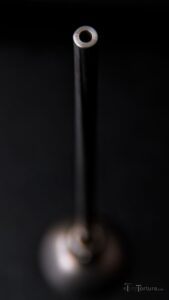
The Banana Jack on top of the Sound
While the eVac 2.0 makes pumping and wearing it for longer periods comfortable, two small pieces of advice regarding pumping:
- Pumping does not make your dick larger! There is an urban legend that exposing your dick to vacuum over extended periods of time, makes it grow. That is a myth! The dick will temporarily become a bit bigger and squishy. And yes, the more intense circulation and usage will help your erecting be stronger and harder (that’s why vacuum pumps can be used to treat erectile dysfunctions). The dick might feel bigger and longer due to that. But it will not grow.
- What can happen if you pump too quickly with too strong vacuum that you damage the tissue inside your dick. Then your dick will be constantly bigger but just squishy. This is aptly called “Sponge Dick”. In order to avoid it pump slowly, carefully and not going to the max vacuum. There should always only be a (light) horny draft, not painful suction!
The material this toy is made out of caused some discussion under my testees. Some drone players loved it for the dark, complete coverage look. Others did not like that you cannot see what is (happening) inside. In good light conditions, you can see the shadow of the meat inside. But under sexy darkroom lighting it is almost impossible to make out if there dick is touching the electrode or not. For many pump pigs, seeing your dick grow inside the cylinder is a big part of the turn on. This is of cause not possible with the dark, almost opaque material.

The eVac with the Plug for Only Vacuum Play
What sets the eVac apart from other vacuum cylinders is the central rod you can istall using the wing nut up top. The rounded tip is made for easy urethra insertion. Before putting it into your dick, you should disinfect the rod properly to avoid infection. Afterwards generously apply (sterile) lube and put the tip into your piss slit. Afterwards generously apply (sterile) lube and put the tip into your piss slit. The most common lube is water-based which had good conductivity and is easy to clean. An pro-alternative is silicone fat (= high viscosity silicone oil). It has a lower conductivity than water-based lube so you have to crank up your box a bit more. But unlike water-based lube, it does not get absorbed by the surrounding tissue or washed away by pre-cum. So when you plan on playing for longer periods of time, give that a try. Though it is a bit messier to clean. Since the rod does not move inside the cylinder, the process takes a bit of practice. The best way to do it is to unscrew the wing nut so the rod can move freely, push the rod all the way down and insert the sound outside the cylinder. Then hold the rod while pushing the cylinder onto your body, tighten the wing nut and start pumping.
The eVac 2.0 can now also be ordered with an 8mm rod which is 2mm less diameter than its predecessor. This should make the sounding part accessible to more people. When it comes to sounds, 8mm is actually the sweet spot between still being able to take it comfortably and not being “pointy”, thus getting down gently. Still, for an inexperience player, 8mm is still significant to pass through the sphincter inside on the tip so some prestretching is recommended.

The Anatomical Shaped Base
There are two ways to get the sound deeper into your dick. First, you can of course unscrew the wing nut and push the rod deeper. In some instances this can loosen the vacuum so you have to re-pump a bit once you have tightened the screw. The other – and unanimously voted hotter – way is by increasing the vacuum. The dick will temporarily increase in size, thus sucking the sound in deeper and deeper.
If you add e-stim to the play, it is getting even hotter! The more contact the dick makes with the rod, the lower the e-stim sensation is felt. It is only subtle, but noticeable. If you then break the vacuum and the dick shrinks a bit, the e-stim sensation will become a bit more intense again.
Of course, in order to create an e-stim sensation, you need a second pole. This could be a conductive rubber loop around the balls or an anal electrode. The e-stim sensation is always felt at the electrode with the lower mass and the smaller contact area. So if you just use a conductive loop, be prepared to only feel the sensation there if the rod goes DEEP. VAST also offers a cylinder eVac Duo 800 with an Ø80mm vacuum tube and a second conductive rod which pressed against your pelvis which costs 269€. I did not have a chance to play with it so I cannot tell how well it works. But if you are looking for a completely integrated vacuum e-stim toy, check it out.
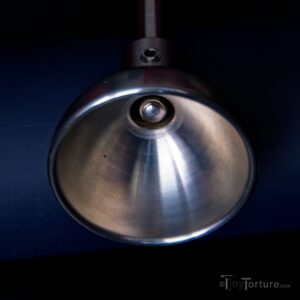
The Bell-Shaped Electrode Attachement
For those of you who do not like sounding, the eVac 2.0 comes with a bell-shaped half shell which can be attached to the rod using a setscrew and a small hex key. This accessory can either be used to limit the depth the rod can go into the dick or if you fix it at just the tip of the rod as the contact surface. Then the half-dome envelops the hard glans pressing against it. Since the contact area is larger, the e-stim sensation is smoother. Depending on where the frenulum presses against the electrode, it can get stimulated intensely which lead to a handsfree orgasm of two testees. Be aware, that cumming from e-stim takes practice and does not come naturally! Most people who start out with e-stim hope to easily cum from it which is the exception, not the rule. While I am on the topic of warnings, be extremely careful when the bottom wears a piercing! As I said, currency always takes the route of lowest resistance which as soon as it touches metal is that focused path. Be extremely careful when ramping the sub in, especially when he is uncut and the Prince Albert is covered by foreskin. If he gets hornier, the foreskin retracts and the piercing makes contact with the electrode, he could be in (unintended and unsexy) excruciating pain!
If you play with e-stim, I highly recommend to wear isolating gloves when handling the eVac 2.0. Currency always takes the way of lowest resistance and thus the shortest way, so you should be fine. But there is a very small chance of currency passing through your heart when touching the rod with your bare fingers. So if you want to be extra safe (if you are not already into [heavy] rubber), wear insulating gloves.
| Conclusion: Excellent vacuum cylinder with a naughty & nice e-stim twist. |
| Pro |
Cons |
Where to get |
Price |
| Unique combination of cock pumping and e-stim |
Opaque material |
VAST |
eVac 500: 179€
eVac 600: 189€ |
| Anatomic base for smoother vacuum seal and better pressure distribution |
| Versatile electrode |
| Vacuum cylinder works also without electrode |
| Easy to clean |



